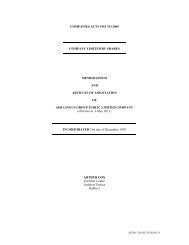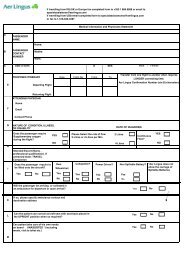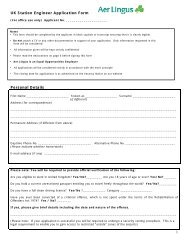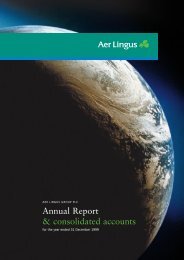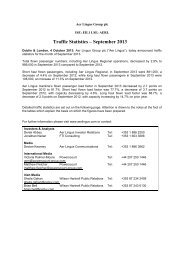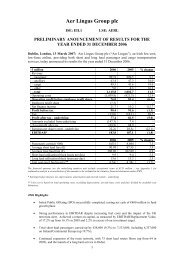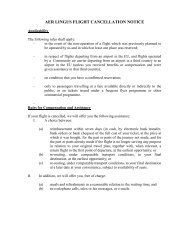annual report 2009 - Aer Lingus
annual report 2009 - Aer Lingus
annual report 2009 - Aer Lingus
Create successful ePaper yourself
Turn your PDF publications into a flip-book with our unique Google optimized e-Paper software.
Financial Statements <strong>Aer</strong> <strong>Lingus</strong> Group Plc – Annual Report <strong>2009</strong>572 Summary of significant accounting policies [continued]2.8 Financial assets2.8.1 ClassificationThe Group classifies its financial assets in the following categories: loans and receivables, held to maturity investments and availablefor-salefinancial assets. The classification depends on the purpose for which the financial assets were acquired. Management determinesthe classification of its financial assets at initial recognition.(a) Loans and receivablesLoans and receivables are non-derivative financial assets with fixed or determinable payments that are not quoted in an active market.They are included in current assets, except for maturities greater than 12 months after the end of the <strong>report</strong>ing period. These areclassified as non-current assets. The Group’s loans and receivables comprise ‘loans and receivables’ and ‘trade and other receivables’in the statement of financial position.(b) Held to maturity investmentsHeld to maturity investments are non-derivative financial assets with fixed or determinable payments and fixed maturities that theGroup has the positive intention and ability to hold to maturity. Were the Group to sell other than an insignificant amount of heldto maturity assets, the entire category would be reclassified as available-for-sale.Held to maturity investments are initially recognised at fair value plus transaction costs and are subsequently carried at amortisedcost using the effective interest method. They are recognised when the rights to receive cash flows from the investments have expiredor have been transferred and the Group has transferred substantially all risks and rewards of ownership.(c) Available-for-sale financial assetsAvailable-for-sale financial assets are non-derivatives that are either designated in this category or not classified in any of the othercategories. They are included in non-current assets unless the investment matures or management intends to dispose of it within12 months of the end of the <strong>report</strong>ing period.2.8.2 Recognition and measurementRegular purchases and sales of financial assets are recognised on the trade-date – the date on which the Group commits to purchaseor sell the asset. Investments are initially recognised at fair value plus transactions costs for all financial assets not carried at fair valuethrough profit or loss. Financial assets carried at fair value through profit or loss are initially recognised at fair value, and transactionscosts are expensed in the income statement. Financial assets are derecognised when the rights to receive cash flows from the investmentshave expired or have been transferred and the Group has transferred substantially all risks and rewards of ownership. Available-for-salefinancial assets and financial assets at fair value through profit or loss are subsequently carried at fair value. Loans and receivables aresubsequently carried at amortised cost using the effective interest method.Changes in the fair value of monetary securities denominated in a foreign currency and classified as available-for-sale are analysedbetween translation differences resulting from changes in the amortised cost of the security and other changes in the carrying amountof the security. The translation differences on monetary securities are recognised in profit or loss; translation differences on non-monetarysecurities are recognised in other comprehensive income. Changes in the fair value of monetary and non-monetary securities classifiedas available-for-sale are recognised in other comprehensive income.When securities classified as available-for-sale are sold or impaired, the accumulated fair value adjustments recognised in equity areincluded in the income statement as ‘gains and losses from investment securities’.Interest on available-for-sale securities calculated using the effective interest method is recognised in the income statement as partof finance income. Dividends on available-for-sale equity instruments are recognised in the income statement as part of finance incomewhen the Group’s right to receive payments is established.The available-for-sale fair value reserve remaining following the reclassification of debt securities previously classified as available-for-saleto loans and receivables is credited to the income statement using the effective interest method.



